MCQs of Basic Electronics 50 Questions
Basic Electronics questions and answers with explanation for interview, competitive examination and entrance test.
For ANS 1=A, 2=B, 3=C, 4=D
1. A resistor with colour bands: red-red-red-gold, has the value:
- 22k 5%
- 2k2 5%
- 220R 5%
- 22R 5%
ANS – B
2. A resistor and capacitor in series is called a:

- Pulse Circuit
- Timing Circuit/Delay Circuit
- Oscillator Circuit/Frequency Circuit
- Schmitt Circuit
ANS – B
3. Connecting a lead from the negative to the positive of a battery will produce:
- A high resistance circuit
- A short circuit
- A low current path
- An open circuit
ANS – B
4. What is the approximate characteristic voltage that develops across a red LED?
- 1.7v
- 3.4v
- 0.6v
- 5v
ANS – A
5. If two resistors are placed in series, is the final resistance:
- Higher
- Lower
- The same
- Cannot be determined
ANS – A
6. Which is not a "common" value of resistance?
- 2k7
- 1M8
- 330R
- 4k4
ANS – D
7. If a small value of capacitance is connected in parallel with a large value, the combined capacitance will be:
- The same
- Higher
- Lower
ANS – B
8. If the voltage on the base of a transistor increases, does it:
- Turn on
- Turn off
- Not enough information
- Remain the same
ANS – C
9. The resistor identified in brown is called the:
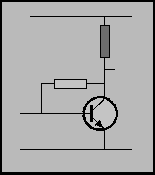
- Base Bias Resistor
- Load Resistor
- Emitter Feedback Resistor
- Bypass Resistor
ANS – B
10. A 100n capacitor in parallel with 10n produces:
- 90n
- 100n
- 110n
- Cannot be determined
ANS – C
11. What does LED stand for?
- Light Emitting Display
- Low Energy Display
- Light Emitting Diode
- Light Emitting Detector
ANS – C
12. The lead marked with the arrow is:

- The Collector
- The Base
- The Emitter
- The case
ANS – C
13. A 10k resistor in parallel with 10k produces:
- 10k
- 5k
- 20k
- Cannot be determined
ANS – B
14. The symbol is:

- NPN Transistor
- PNP Transistor
- Photo Transistor
- Field Effect Transistor
ANS – B
15. Two 3v batteries are connected as shown. The output voltage is:

- 3v
- 0v
- 6v
ANS – B
16. 4 resistors in ascending order are:
- 22R 270k 2k2 1M
- 4k7 10k 47R 330k
- 3R3 4R7 22R 5k6
- 100R 10k 1M 3k3
ANS – C
17. The closest value for this combination is:

- 4k7
- 2k3
-
9k4
ANS – B
18. This stage is called:
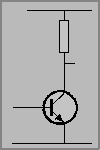
- Common Base
- Common Collector
- Common Emitter
- Emitter Follower
ANS – C
19. The four symbols are:

- Capacitor, Microphone, Potentiometer, Electrolytic
- Electrolytic, Microphone, Resistor, Capacitor
- Capacitor, Piezo, Resistor, Electrolytic
- Electrolytic, Coil, Resistor, Capacitor
ANS – A
20. The value of the combination is:

- 100n
- 200n
- 50n
ANS – B
21. The resistor marked in red is:

- Base Bias Resistor
- Load Resistor
- Emitter Feedback Resistor
- Bypass Resistor
ANS – A
22. Name the three leads of a common transistor
- Collector Bias Omitter
- Base Collector Case
- Emitter Collector Bias
- Collector Base Emitter
ANS – D
23. A red-red-red-gold resistor in series with an orange-orange-orange-gold resistor produces:
- 5k5
- 35,200 ohms
- 55k
- None of the above
ANS – B
24. Name the 4 components:

- Photo transistor, switch, capacitor, coil
- Transistor, mercury switch, piezo, coil
- Photo transistor, reed switch, piezo, coil
- Photo darlington transistor, reed switch, piezo, coil
ANS – D
25. To obtain a higher value of resistance, resistors are connected in:
- Reverse
- Forward
- Parallel
- Series
ANS – D
26. A capacitor and coil in parallel is called:

- A Tuned Circuit
- A Timing Circuit
- A Delay Circuit
- A Schmitt Circuit
ANS – A
27. When the base is raised, the emitter will:
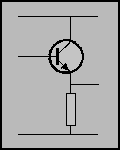
- Rise
- Fall
- Remain Fixed
- Oscillate
ANS – A
28. What is 1,000p?
- 0.01n
- 0.0001u
- 0.1n
- 1n
ANS – D
29. The current in a circuit is 45mA. This is:
- 0.045Amp
- 0.00045A
- 0.0045A
- 0.45A
ANS – A
30. A 100n capacitor can be expressed as:
- 0.1u u = microfarad
- 0.01u
- 0.001u
- none of the above
ANS – A
31. 1mA is equal to:
- 0.001A
- 0.00001A
- 0.01A
- 0.1A
ANS – A
32. 1,200mV is equal to:
- 12v
- 1.2v
- 0.12v
- 0.0012v
ANS – B
33. If a 10k resistor is placed across a 10v supply, the current will be:
- 10mA
- 1mA
- 0.01mA
- 0.1mA
ANS – B
34. For the XOR gate, what is the output when both inputs are HIGH:

- HIGH
- LOW
- Can be HIGH or LOW
- Cannot be determined
ANS – B
35. This arrangement is called:
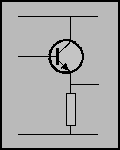
- Common Emitter
- Common Collector/Emitter Follower
- Common Base
ANS – B
36. Identify the correctly connected LED:
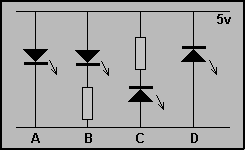
- A
- B
- C
- D
ANS – B
37. Identify the correct statement:

- The cathode lead is longer. It goes to the negative rail
- The cathode lead is shorter. It goes to the negative rail
- The cathode lead is shorter. It goes to the positive rail
- The cathode lead is longer. It goes to the positive rail
ANS – B
38. The signal at the collector will be . . .

- Inverted . . .
- In-phase . . .
. . . with the base.
ANS – A
39. The purpose of the capacitor:
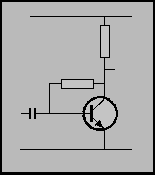
- To pass AC on the input to the base
- To allow the transistor to self-bias
- Block DC from the input line
- To allow the stage to operate
ANS – C
40. The direction of conduction for a diode is:

- A
- B
- C
ANS – A
41. A DC voltage . . .
- rises and falls
- is a sinewave
- remains constant
- is an audio waveform
ANS – C
42. A CRO is a
- Cathode Ray Oscillator
- Cathode Ray Oscilloscope
- Capacitor-Resistor Oscillator
- Capacitor-Resistor Output
ANS – B
43. These jargon terms mean: (Jargon = language peculiar to a 'mickey' 'electro' 'cap' 'puff'; trade)
- mighty, electronic, capper, picofarad
- microfarad, electronic, capacitor, picofarad
- microfarad, electrolytic, capacitor, picofarad
- microfarad, electrolyte, capping, blow
ANS – C
44. The tolerance bands: gold; silver; brown, represent:
- 10%, 5%, 1%
- 5%, 10%, 2%
- 5%, 10%, 1%
- 10%, 5%, 2%
ANS – C
45. 223 on a capacitor represents:
- 0.022u u = microfarad
- 22n n = nanofarad
- 22,000p p = picofarad
- All of the above
ANS – B
46. Arrange these in ascending order: n, p, u
- p, u, n,
- n, u, p
- p, n, u
ANS – C
47. Name this symbol:

- A buffer
- A NOR gate
- A NAND gate
- A Schmitt Trigger
ANS – D
48. The number "104" on a capacitor indicates:
- 0.1u
- 100n
- 1n
- 10n
ANS – A & B (Both)
49. What is the Multimeter detecting?

- The output voltage of the Schmitt Trigger
- The delay across the capacitor
- The voltage across the capacitor
- The current through the capacitor
ANS – C
50. The current requirement of a LED is:
- 1.7mA
- 25mA
- Between 3 and 35mA
- 65mA
ANS – C



